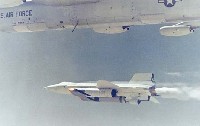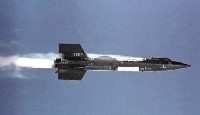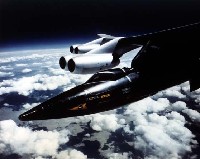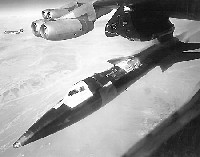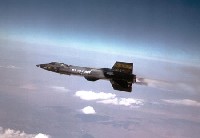|
Global Aircraft -- X-15
Aviation Center
US Attack
US Bombers
US Cargo
US Fighters
US Helicopters
US Patrol/Pursuit
US Reconnaissance
US Tankers
US Trainers
US UAV's
US X Planes
Orbiter Vehicles
WWI Aircraft
WWII Aircraft
Airbus
Antonov
Boeing
Dassault
Ilyushin
Kamov
MiG
Mil
Saab
Sukhoi
Tupolev
Yakovlev
Joint/Rest of World
Entertainment Center
Members Center
New Technologies
Contact Us
Extra Navigation
GAC Engine
X-15 Specifications
X-15 Achievements
X-15 Background
On March 10, 1959, North American pilot Scott Crossfield completed the first captive-carry flight under the B-52 mothership. Again on June 8, 1959, Crossfield made the X-15's first glide flight -- reaching a speed of 522mph (mach 0.79) from the release altitude of 37,550ft. The X-15 was created under the USAF project MX-1226. Since the expected XLR99 rocket motor (rated at 57,850lb.) wasn't available at first, the X-15 was powered by two XLR11 rocket motors rated at 8,000lb. thrust each for a short time. It reached a top speed of mach 2.11 (1,455mph) and a ceiling of 52,341ft during the first powered flights with the XLR11's. On November 9, 1962, an engine failure made pilot Jack McKay make an emergency landing at Mud Lake, Nevada. Upon landing, the landing gear collapsed and the X-15 flipped over. The pilot survived, but was forced to retire due to injuries. The X-15A #2 was sent back to North American, where it went through extensive repairs and modifications. When X-15A-2 returned to Edwards in February 1964, it was equipped with a longer fuselage and external fuel tanks. On the last X-15 flight (flight number 199) on October 3, 1967, Captain William Knight took the X-15A-2 to 102,100ft. and mach 6.70 (4,520mph). X-15A-2 was the fastest of the 3 built, and X-15A #3 was the highest flying (354,200ft.). X-15A-2 is on display at the USAF Museum in Dayton, Ohio. X-15A #1 is on permanent display at the National Air and Space Museum in Washington D.C. X-15A #3 disintegrated after the aircraft entered a spin during re-entry at mach 5. At around 18,600ft the aircraft started to dive with high frequency pitch oscillations. When X-15A #3 reached 15Gs, the plane broke up -- killing its pilot Michael J. Adams. The X-15 was the first aircraft to exceed mach 4, 5, and 6 -- and it was the first aircraft to exceed 100,000ft, 200,000ft, and 300,000ft altitude. Summary Copyright © Charles M (JetWhiz) | ||||||||||||||||||||||||||||||||||||||||||||||||||||||||||||||||||||||||||||||


